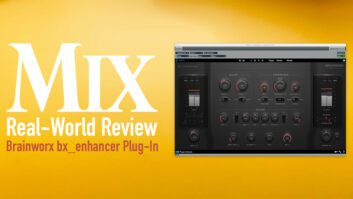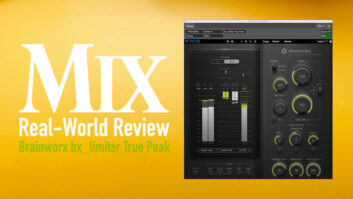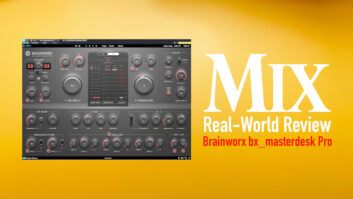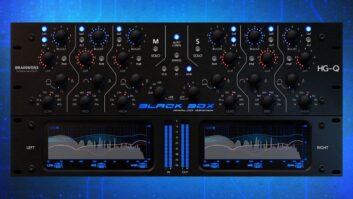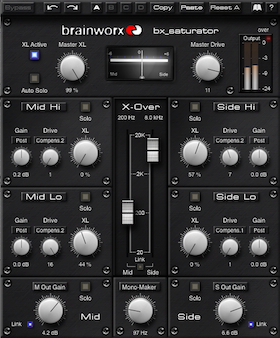
Fig.1: bx_saturator adds independent harmonics processing to two frequency bands for mid and side channels each.
PRODUCT SUMMARY
COMPANY: Brainworx
PRODUCT: bx_saturator
WEBSITE:plugin-alliance.com
PRICE: $229 MSRP
PROS: Excellent sound quality. M/S and splitband processing. Easy to learn. Light CPU drain.
CONS: Wet signals lack LPFs. No stereo or dual-mono mode. Heightened signal peaks require following the plug-in with a brickwall limiter for mastering use.
bx_saturator is a new processor belonging to Brainworx’s Rock ’n’ Roll line of plug-ins, but it’s a scion of sorts. The heart of the mid/side (M/S) plug-in is its XL saturation algorithm, which was first introduced in the outstanding bx_XL plug-in, a mid/side mastering limiter.
You can apply XL saturation (adding third- and fifth-order harmonics) independently to four frequency bands, two for each channel: Mid Hi and Lo, and Side Hi and Lo. (Mono operation uses two bands total.) But facility is not the main talking point. Its excellent sound quality is what makes bx_saturator enthralling.
The cross-platform plug-in is available in AU, VST, VST3, RTAS and AAX formats. I reviewed Version 1.0.3 of the AU plug-in in Digital Performer 7.21, using an 8-core Mac Pro running OS X 10.6.8.
Brainworx belongs to the Plugin Alliance, a strategic consortium of plug-in manufacturers that also includes SPL, elysia, Chandler, Noveltech and Vertigo Sound. The Alliance licenses and distributes member companies’ plug-ins and provides after-purchase service. All Alliance plug-ins are activated with just one disk-based license and can be used on as many as three computers. No iLok or other hardware dongle is required.
The Lay of the Land
In the center of bx_saturator’s GUI, separate sliders for mid- and side channels adjust the crossover frequencies for their respective Hi and Lo bands (see Fig. 1). The two sliders can be linked so that they move in tandem when either one is adjusted.
Each of the four frequency bands features independent rotary controls for adjusting the amount of XL processing, drive and gain. The drive control regulates the amount of distortion generated in the band, while the XL control sets the relative balance between the processed and dry audio at the band’s output. A pop-up menu above each band’s drive control allows you to select one of two so-called compensation modes of operation; they reduce the band’s output level to counteract any boost in output caused by turning up the drive control for the band. In response to my press for more details, Brainworx would only say the compensation modes work in non-linear, dynamic fashion but not like a compressor or limiter. In my tests, compensation mode 2 always provided louder output than compensation mode 1. You can turn gain compensation off, if you wish.
The gain control for each band can be set to adjust gain either before (pre setting) or after (post) the drive control. The pre setting allows you to optimize the level of dry signal feeding the drive control. The post setting lets you adjust the output level of the band without affecting the amount of distortion dispensed by your drive control setting.
Master XL and drive controls adjust the XL and drive amounts for all four bands simultaneously while maintaining the offsets among them. Once you have the ratio of processing among the four bands the way you like, you can use these master controls to boost or attenuate the overall amount of processing without screwing up your carefully wrought balance. The slaved controls animate when you adjust their master, providing useful visual feedback.
XL saturation processing can be bypassed independently for each frequency band and globally. When you bypass a band, its signal passes through at unity gain. The global XL bypass does not affect the Mono Maker or mid- and side-channel output level controls (located in the bottom strip of the GUI). The continuously variable Mono Maker control allows you to narrow to mono the soundstage of all frequencies below the corner frequency you select.
You can solo an individual band in one of two ways: Either click on its dedicated solo switch or activate the Auto Solo function for the entire plug-in. The active Auto Solo function automatically solos a frequency band’s output when you mouse-click and hold its drive or XL control (until you release your mouse). Soloing makes it easier to hear how much distortion the XL processing is adding in a particular band.

Fig. 2: When used on a mono track, Mono Maker and side channel controls are grayed out.
Separate output-gain controls are provided for mid and side channels. Link the two gain controls to adjust the plug-in’s overall output levels. Unlink the controls to tweak the stereo image; for example, boost the side-channel’s gain to increase the track’s stereo width and overall ambience. An innovative Mid/Side meter shows the relative balance in output between the two channels. Dual LED-style meter ladders show output levels for left and right channels. An Over indicator lights when your stereo output clips.
The top toolbar in the GUI allows you to bypass the plug-in, execute as many as 32 steps each of Undo and Redo, and store your custom control setups in four discrete workspaces for comparison purposes. The toolbar also provides one-click access to the operating manual.
Soaking Tracks
I could use bx_saturator on loads of tracks with impunity, as it imposed very light drain on my CPU. The plug-in’s operation was easy to learn. When you instantiate bx_saturator on a mono track, the Mono Maker and all side-channel controls become grayed out and unavailable, as is logical (see Fig. 2).
On kick drum, I set bx_saturator’s crossover to 5.8 kHz. I cranked the Mid Hi band’s drive and XL controls in compensation mode 2, then lowered its post-drive gain a couple dB to keep the kick from sounding too clicky from the added high-frequency distortion. The flattering result was a kick-drum track that popped more.
bx_saturator sounded outrageous when I used it on drum room mics on a rockin’ country production. I applied generous amounts of drive to the Mid Lo channel below 200 Hz and to the Side Hi channel above 8 kHz. Setting the Mono Maker to 97 Hz tightened up the bottom end, and goosing the side channel’s output gain cranked the ambience and widened the stereo field. Linking the output-gain controls allowed me to adjust them both simultaneously and proportionally to optimally drive a downstream compressor plug-in set to stun. The result sounded explosive.
I could get a variety of great vocal sounds using bx_saturator. Light XL processing above 12.7 kHz and moderate post-drive gain added sweet air to a female vocal track. Lowering the crossover to 422 Hz made the track sound more broadly present, if perhaps a tad too bright when the vocalist sang at the top of her range. The solution was to boost the Mid Lo band’s gain a couple dB (without applying XL processing to that band). That restored body to the track and perfectly complemented the sparkling clarity added by XL processing in the Mid Hi band. The only downside was that sibilance was slightly amplified. I found myself wishing for an adjustable lowpass filter (LPF) for each of the Hi bands’ wet signals. LPFs would help quell sibilance and generally allow greater processing depth without sounding edgy.
bx_saturator sounded great on stereo electric guitars, adding crunch (XL processing added primarily above 200 Hz), tightening the bottom end (setting the Mono Maker control to 104 Hz) and widening the stereo image (setting the side channel’s output gain a couple dB higher than that for the mid channel).
I got mixed results using bx_saturator in a mastering session. Applying extremely light XL processing equally across all bands made the mix sound richer, but the additional gain inherent to the processing forced me to lower the plug-in’s outputs around 6 dB to prevent snare hits from exceeding 0 dBFS. Doing so lowered the mix’s RMS levels and made it sound significantly quieter. The Brainworx bx_XL mid/side limiter plug-in is a better tool for mastering, as it places a defeatable brickwall limiter after XL processing in the signal chain to rein in excessive peaks.
bx_saturator also lacks stereo and dual-mono modes that would be useful for both mixing and mastering. For de facto stereo operation, set the crossovers for mid- and side channels to the same frequencies and match the control settings for identical frequency bands.
The Upshot
bx_saturator would provide even greater harmonious latitude for processing depth if it offered adjustable LPFs for its Hi bands’ wet signals. But even missing this refinement, the plug-in is an outstanding tool for adding sparkle, luster and grit to tracks during mixdown. There are many saturation plug-ins on the market, but bx_saturator is one of the best sounding of the lot.
Mix contributing editor Michael Cooper (myspace.com/michaelcooperrecording) is a mix and mastering engineer based in Oregon.
TRY THIS
For a burpy and thunderous electric bass sound, boost only the Mid Lo band’s drive control on the track. Set the mid channel’s crossover to 200 Hz and the XL control to roughly 50 percent wet/dry mix. Nosedive the post-drive gain for the Mid Hi band 80 dB to kill all dry signal above 200 Hz. The harmonics generated in the low band will add bass and midrange grit, while attenuating the high band will keep the overall sound from becoming too bright.


